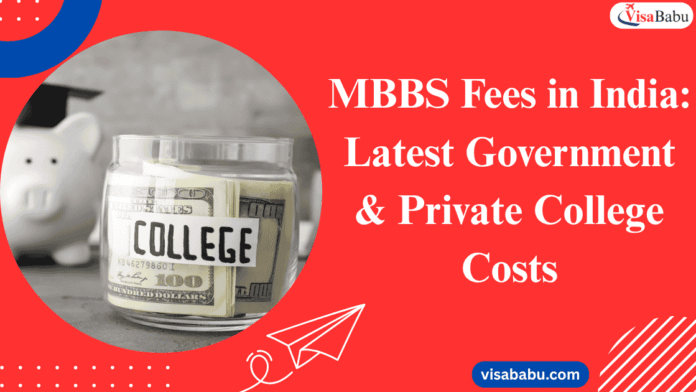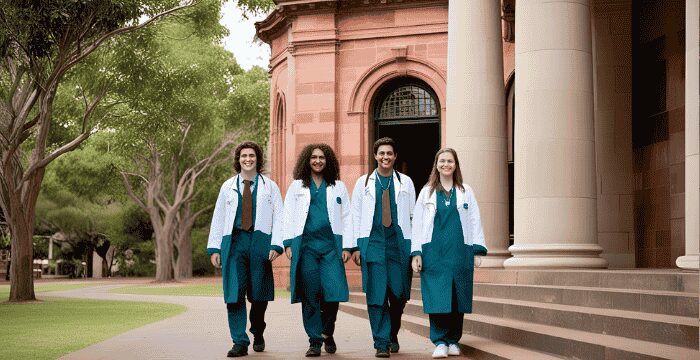MBBS fees in India vary dramatically across different types of institutions, making it crucial for aspiring medical students to understand the complete cost structure before making their educational investment. The fees for Indian MBBS colleges can range from ₹6,000 to ₹1 crore, and there are around 759 such colleges. This guide looks at the different parts of medical education costs to support your decision about choosing a medical career.
Recent News and Facts Section (2025)
The medical education landscape in India continues to evolve with significant developments affecting MBBS fees in India. At present, 88 public universities offer MBBS for ₹10,000-₹50,000 every year, while private universities charge anywhere from ₹3-25 lakhs1. The course at AIIMS Delhi only costs ₹6,100 in total, so it is one of the cheapest ways to get a medical education.
Due to government actions, there are now 15% more MBBS seats available for students in the last two years. But, private colleges sometimes require students to pay a management quota fee of up to ₹17.95 lakhs per year4. Private college fee structures are set to be standardised through new NMC rules in 2025, which may improve the transparency of admissions.
Understanding the Course Structure and Duration
All medical schools in India use the same standard pattern for their courses. In all, the MBBS program takes 5.5 years, made up of 4.5 academic years and a required 1-year internship. With this system, students are able to learn and practice many concepts in medicine to become licensed doctors.
MBBS training is split into three sections:
- Pre-clinical phase: The first part of the pre-clinical phase covers basic sciences in medicine for 1.5 years
- Para-clinical period: Next 1.5 years, concentrate on pathology and pharmacology
- Clinical phase: Final 1.5 years when medical students care for patients and explore specialities
- Internship: One year of monitored practical experience
| Phase | Duration | Focus Area | Key Subjects |
| Pre-clinical | 1.5 years | Basic Sciences | Anatomy, Physiology, Biochemistry |
| Para-clinical | 1.5 years | Applied Sciences | Pathology, Pharmacology, Microbiology |
| Clinical | 1.5 years | Patient Care | Medicine, Surgery, Pediatrics, Gynecology |
| Internship | 1 year | Practical Training | Rotational postings in all departments |
Cost of MBBS in Government Medical Colleges in 2025
Details of the fee structure for the top Government Medical Colleges
Government medical colleges offer the most affordable MBBS fees in India, making quality medical education accessible to students from all economic backgrounds. Only ₹6,100 is charged by AIIMS institutions for the entire course at AIIMS Delhi, which is the lowest fee for MBBS in India.
| College Name | Annual Fees | Total Course Fees | Additional Charges |
| AIIMS Delhi | ₹1,525 | ₹6,100 | Hostel: ₹5,960 |
| AIIMS Bhopal | ₹6,035 | ₹24,140 | Minimal additional costs |
| JIPMER Puducherry | ₹3,500 | ₹14,000 | Free accommodation |
| PGIMER Chandigarh | ₹10,000 | ₹40,000 | Subsidized hostel |
| CMC Vellore | ₹12,000 | ₹48,000 | Merit-based scholarships |
Affordable fees are set at many other top government agencies. Between the two, IPGMER Kolkata costs more with fees of ₹40,500 a year compared to Tirunelveli Medical College, where students must pay just ₹18,500 annually. Because they are heavily funded by the government, these institutions can give top medical education at low fees.
Government College Fees Differ Across States (2025)
MBBS fees in India for government colleges vary significantly across states due to different funding policies and administrative structures. When students know these variations, they can find the most affordable areas to live in that suit them.
| State | Average Annual Fees | Notable Colleges | Special Benefits |
| Delhi | ₹60,000 – ₹2,30,000 | UCMS, VMMC | Central government funding |
| Maharashtra | ₹78,379 – ₹1,80,000 | GMCH, CIMS Bilaspur | State quota advantages |
| Karnataka | ₹40,000 – ₹1,20,000 | Mysore Medical College | Technology integration |
| Uttar Pradesh | ₹250 – ₹70,900 | BHU, KGMU | Large seat availability |
| Tamil Nadu | ₹18,500 – ₹85,000 | Tirunelveli Medical | Research opportunities |
The variation in MBBS fees in India across states reflects different policy approaches. Students from Uttar Pradesh pay very low fees for the state quota, compared to those from Delhi, who pay more but receive better facilities and services.
Tuition Costs in Private Medical Colleges in 2025
Ranges of Private College Fees and Considerations
Private medical colleges charge significantly higher MBBS fees in India, with costs ranging from ₹3 lakhs to ₹25 lakhs annually1. Because they allocate lots of money to infrastructure, teachers and new equipment, they can justify the extra cost charged to students.
Many things influence the fees at private colleges.
- More expensive: Metropolitan colleges because they need better facilities
- Accreditation and ranking: Established institutions with a high level of accreditation receive higher tuition.
- Faculty quality: If the faculty is experienced, it tends to increase the overall running costs.
- Research facilities: Investment is needed for research centres to have advanced labs and equipment
- Hospital affiliations: Being affiliated with teaching hospitals that have updated facilities is more expensive for hospitals.
| Fee Range | Number of Colleges | Typical Features | Target Students |
| ₹3-8 lakhs | 45 | Basic facilities | Middle-class families |
| ₹8-15 lakhs | 62 | Good infrastructure | Upper-middle class |
| ₹15-20 lakhs | 28 | Premium facilities | Affluent families |
| ₹20-25 lakhs | 9 | Luxury amenities | High-income groups |
Management quota and regular quota fees are different.
The quota system significantly impacts MBBS fees in India in private colleges. Quota seats set by the government are cheaper, but management quota seats can be more expensive.
The Daily, Weekly and Monthly Features are part of the regular Quota Features.
Policies that oversee how fees are established
- The process of getting into medical college by scoring in the NEET
- You do not need to pay the management quota fee.
- Only half the total number of seats are available (usually).
Management Quota Features:
- Fees are set by the college.
- Getting a higher score on the NEET exam remains necessary.
- Surcharges are about 2 to 3 times higher than the regular quota.
- Less rigid rules for being admitted
| Quota Type | Fee Range | Admission Process | Seat Availability |
| Government Quota | ₹3-8 lakhs | NEET counseling | 50% of seats |
| Management Quota | ₹8-25 lakhs | College-specific | 50% of seats |
| NRI Quota | ₹15-35 lakhs | Direct admission | 15% of seats |
| Institutional Quota | ₹10-20 lakhs | College criteria | Variable |
MBBS Fees: State-Wise Breakdown in 2025
The cost to study in Delhi for MBBS
Delhi offers diverse options for medical education, with MBBS fees in India ranging from extremely affordable government colleges to premium private institutions. The country’s most well-known medical institutions are in the national capital.
Colleges Admissions in Delhi Government:
- There will be a ₹6,100 charge for the full course at AIIMS Delhi.
- UCMS is about ₹1 lakh.
- VMMC fees are ₹80,000 every year.
- Lady Hardinge Medical College: ₹75,000 each year
There are a number of private colleges in Delhi.
- Hamdard Institute receives ₹16 lakhs annually
- Annual expenses at Jamia Hamdard are ₹18 lakhs.
- Deemed universities may charge students ₹20-25 lakhs every year.
Bachelor of Medicine and Bachelor of Surgery (MBBS) Fees in Maharashtra in 2025
Maharashtra hosts numerous medical colleges with varying MBBS fees in India. There are affordable public services as well as well-equipped private institutions available.
| College Type | Annual Fees | Notable Institutions | Special Features |
| Government | ₹78,379 – ₹1,80,000 | GMCH, CIMS Bilaspur | Research focus |
| Private | ₹20-25 lakhs | Bharati Vidyapeeth, Krishna Institute | Modern facilities |
| Deemed | ₹20-26 lakhs | D.Y. Patil colleges | Industry connections |
Costs of MBBS Study in Karnataka in 2025
What makes Karnataka unique is how it balances the prices for medical education. The state offers excellent MBBS fees in India options across all categories of institutions.
Government Colleges:
- Mysore Medical College: It is estimated to cost around ₹2 lakhs.
- Bangalore Medical College: Annual Fees at Bangalore Medical College are ₹1.5 lakhs.
- Karnataka Institute of Medical Sciences: The approximate tuition fee for Karnataka Institute of Medical Sciences is ₹1.8 lakhs a year.
These are the Private and Deemed Universities.
- Kasturba Medical College (Manipal): The annual fee at Kasturba Medical College (Manipal) is ₹17.70 lakhs.
- JSS Medical College: the cost is ₹18.50 lakhs each year.
- KLE University: The total expense for a year at KLE University is ₹18.25 lakhs.
Fees for MBBS in Uttar Pradesh
Uttar Pradesh offers some of the most affordable MBBS fees in India for government college students, making medical education accessible to economically weaker sections.
Fee Structure:
- State quota students: State quota students pay between ₹250 and ₹70,900 every year.
- All India quota: Fees are higher in the All India quota.
- Private colleges: The tuition costs at private colleges can be between ₹8 and ₹20 lakhs every year.
- Management quota: Management quota fees are typically ₹15-25 lakhs every year.
Costs for MBBS in Tamil Nadu in 2025
Tamil Nadu maintains competitive MBBS fees in India while offering quality medical education. There are both government and private institutions in the state.
| Institution Category | Annual Fees | Examples | Unique Features |
| Government | ₹18,500 – ₹85,000 | Tirunelveli Medical | Tamil medium option |
| Private | ₹20-25 lakhs | Sri Ramachandra, Chettinad | Research excellence |
| Deemed | ₹22-25 lakhs | SRM, Saveetha | International exposure |
The university shares the fee structure for MBBS (2025).
Deemed universities occupy a unique position in India’s medical education landscape, offering MBBS fees in India that are higher than government colleges but often provide superior infrastructure and facilities. They are recognised as universities and manage their own programs and costs more independently.
Main Features of Deemed Universities
- Autonomy within universities for how to operate
- More expensive than government colleges
- More and improved infrastructure and facilities
- Working with companies and having access to research funding
- International collaborations
| Deemed University | Annual Fees | Established | Special Features |
| Manipal Academy of Higher Education | ₹17.70 lakhs | 1953 | Global recognition |
| JSS Academy of Higher Education | ₹18.50 lakhs | 1984 | Research focus |
| Sri Balaji Vidyapeeth | ₹22 lakhs | 2002 | Modern curriculum |
| Bharati Vidyapeeth | ₹21.33 lakhs | 1989 | Multiple campuses |
| Krishna Institute of Medical Sciences | ₹22.50 lakhs | 1984 | Rural healthcare focus |
The MBBS fees in India for deemed universities typically range from ₹16 lakhs to ₹26 lakhs annually. They charge higher tuition fees because they have better facilities, skilled faculty, and improve students’ chances of getting placed.
Expenses Besides the Cost of School Fees in 2025
Hostel and Accommodation
Understanding the complete cost structure requires considering accommodation expenses alongside MBBS fees in India. There is a big difference in hostel prices between government and private educational establishments.
Hostels are run by the government.
- AIIMS hostels require students to pay ₹5,960 every year.
- Colleges funded by state government budgets cost anywhere from ₹8,000 to ₹25,000 every year.
- Basic items are all supplied.
- Fully subsidised cafeterias
Hostels are available at private colleges.
- Premium rooms can be expected to require yearly fees in this range: ₹50,000-1,50,000
- Modern AC and a variety of services
- Broader mess fees
- Services that can be added for an extra fee
| Accommodation Type | Annual Cost | Facilities Included | Target Students |
| Government Hostel | ₹8,000-25,000 | Basic amenities, mess | Budget-conscious |
| Private Hostel | ₹50,000-1,50,000 | Premium facilities | Comfort-seeking |
| PG Accommodation | ₹30,000-80,000 | Flexible options | Independent living |
| Shared Apartments | ₹25,000-60,000 | Cost-effective | Group living |
Books, studying equipment and course materials 2025
Medical education requires substantial investment in books and equipment beyond basic MBBS fees in India. Textbooks, instruments and online resources are necessary for students in medicine.
Essential Materials to Prepare for IELTS
- Textbooks: The full set of textbooks costs between ₹30,000 and ₹50,000.
- Medical instruments: The medical instruments required are worth ₹15,000-25,000.
- Stethoscope and basic equipment: The cost of the stethoscope and basic equipment is between ₹8,000 and ₹15,000.
- Digital subscriptions: The annual cost of digital subscriptions is usually ₹5,000-10,000.
- Laboratory coats and accessories: Laboratory uniforms and gear prices are in the range of ₹3,000 – ₹5,000.
Application, registration and exam fees (2025)
Various examinations and registrations add to the total cost of medical education beyond basic MBBS fees in India.
| Examination/Registration | Cost | Frequency | Purpose |
| University Examinations | ₹2,000-5,000 | Semester-wise | Academic progression |
| Medical Council Registration | ₹5,000-10,000 | One-time | Practice license |
| NEXT Examination | ₹4,000-8,000 | One-time | Exit examination |
| Internship Registration | ₹2,000-5,000 | One-time | Clinical training |
Funding and Scholarships for MBBS Students in 2025
Funded by the Government
The government offers numerous scholarship programs to make the MBBS fees in India more affordable for deserving students. The schemes divide students into different groups according to how well they do academically, their economic status and their social class.
Extensive list of Government Scholarships:
- PM-USP (Prime Minister’s Scholarship): Students in the 4th and 5th years are given ₹20,000 annually via the PM-USP (Prime Minister’s Scholarship).
- ONGC Scholarship: This scholarship for SC/ST/OBC students is ₹48,000 per year from ONGC.
- State Government Scholarships: There are state government scholarships, which are usually worth ₹10,000-30,000 every academic year.
- Merit-based Scholarships: Merit-based Scholarships are given to the best NEET students.
Requirements for Eligibility in PM-USP:
- 9 or 10 grades in the 80th percentile or better in Class 12
- People with a yearly income under ₹4.5 lakhs
- Studying MBBS in recognised universities
- Allocations of seats for SC/ST/OBC students
Both Private Scholarships and Educational Loans
Private organisations and banks offer various financial assistance options to reduce the burden of MBBS fees in India.
Important Features of Educational Loans:
- Loan amount: The maximum loan a student may get for medical education is ₹1.5 crores.
- Interest rates: The interest you get is between 8.5% and 12% annually.
- Repayment period: The borrower will repay the loan within 10 to 15 years.
- Moratorium period: 1 year after the end of the course
- Collateral requirements: Collateral is usually needed for loans that are larger than ₹7.5 lakhs
| Bank/Institution | Maximum Loan Amount | Interest Rate | Special Features |
| SBI | ₹1.5 crores | 8.85% onwards | Quick processing |
| HDFC Bank | ₹1 crore | 9.5% onwards | Flexible repayment |
| ICICI Bank | ₹1 crore | 9.75% onwards | Digital application |
| Axis Bank | ₹75 lakhs | 10% onwards | Competitive rates |
Financial aid that depends on personal merits
Many institutions offer merit-based scholarships to reduce MBBS fees in India for exceptional students. They acknowledge academic success and motivate talented people to study medicine.
Different Types of Merit Scholarships:
- NEET rank-based: For NEET score ranking among the top 1000
- Academic performance: The student’s academic performance is measured by how they do in each semester.
- Research scholarships: Research scholarships are intended for students who conduct research.
- Sports scholarships: Sports scholarships are available for athletes at the national/state levels.
Factors Affecting MBBS Fees in India in 2025
Several factors influence the variation in MBBS fees in India across different institutions. Knowing about these elements helps students decide what education path to choose in medicine.
Primary Factors:
- Government money: Government colleges are given a lot of financial assistance by the government
- Infrastructure quality: Good quality infrastructure adds to the overall costs of a business
- Faculty expertise: Experienced faculty members tend to get paid more than others.
- Where the business is located matters: cities and towns have higher costs of doing business.
- Accreditation status: Ratings from NAAC and NBA can influence fee amounts.
- Hospital affiliations: Being a teaching hospital is very expensive for hospitals.
Secondary Factors:
- Research facilities: Labs and equipment for advanced research
- Working together with other countries: Through exchange and partnership opportunities
- Student services: Support services at the university include counselling, placement and support.
- Technology integration: The use of information technology in education.
| Factor | Impact on Fees | Government Colleges | Private Colleges |
| Government Funding | High | Significant subsidy | Minimal support |
| Infrastructure | Medium | Basic to good | Premium facilities |
| Faculty Quality | Medium | Experienced | Highly qualified |
| Location | High | Variable | Premium locations |
| Research Focus | Low | Limited | Extensive |
How the fees for MBBS courses compare in India and abroad.
Comparing MBBS fees in India with international options helps students understand the value proposition of domestic medical education.
Differences Between India and the World:
| Country | Annual Fees (INR) | Total Cost | Duration | Recognition |
| India (Government) | 10,000-50,000 | 2-5 lakhs | 5.5 years | MCI/NMC approved |
| India (Private) | 3-25 lakhs | 15 lakhs-1.25 crores | 5.5 years | MCI/NMC approved |
| Russia/Ukraine | 3-5 lakhs | 25-40 lakhs | 6 years | WHO/MCI recognised |
| Philippines | 4-6 lakhs | 30-45 lakhs | 5.5 years | WHO recognized |
| China | 3-4 lakhs | 25-35 lakhs | 6 years | WHO/MCI recognised |
| USA/UK | 50-80 lakhs | 3-5 crores | 4-6 years | Global recognition |
Reasons Why Students Should Study in India in 2025
- Significantly cheaper tuition fees, mostly in government colleges
- Nobody will be denied access because of language.
- A cultural environment that people are familiar with
- Individuals may practice medicine in India directly.
- Experience treating people from a wide variety of backgrounds
Things to Think About for International Study
- More total money has to be invested.
- Other licensing tests are needed for practising in India.
- Difficulties of adapting to a new culture
- Problems with getting a visa or a living permit
How to Reduce the Expenses of an MBBS Education in 2025?
Effective financial planning can significantly reduce the burden of MBBS fees in India. The following are some useful ways for students and their families.
Pre-Admission Planning:
- Start putting money aside for your education in medicine early.
- Explore many different options for scholarship opportunities.
- Examine the total expenses at several different colleges.
- Consider that prices can be different in different parts of the country.
- Check the rates and types of loans available.
While you are managing the course:
- Search for and apply for scholarships each year.
- Take part in research studies to get financial compensation.
- You could look for opportunities to tutor students part-time.
- Try to get used items such as books and other supplies.
- Try to share a home or apartment to make the costs cheaper.
The Strategies for Financial Planning
| Strategy | Potential Savings | Implementation | Risk Level |
| Government College Admission | 80-90% | High NEET score | Low |
| Scholarship Applications | 20-50% | Merit/need-based | Medium |
| Educational Loans | Spread costs | Bank approval | Medium |
| Part-time Income | 10-20% | Time management | High |
| Cost Optimization | 15-25% | Smart choices | Low |
Advantages to Your Pocketbook Over the Long Run
- People in the medical field have a regular and dependable income.
- Specialisation makes it possible to earn more money.
- Types of government jobs with stable security
- You may choose to practice law in a private firm.
- A professional can have a global career with these qualifications.
What to Expect in MBBS Fee Structures Going Forward?
The landscape of MBBS fees in India continues to evolve with changing government policies and market dynamics. Many factors are influencing the future of how much medical education will cost.
Expected Changes:
- Fee Regulation: Tighter laws by the government to control college fees
- Standardisation: Generally, there are the same fee structures for institutions that are similar.
- Adopting Technology: Digital learning helps lower some expenses.
- More seats in government colleges: Less pressure for students.
- Quality Focus: Outcome-based fee justification is the main priority for the quality team.
Government Initiatives:
- National Medical Commission’s rules
- Putting more funds into medical education
- Working together in medical education through public-private partnerships
- Programs are designed to create more scholarships
- Investments in infrastructure at government colleges
Market Trends:
- There is a rising interest in having more people educated in medicine.
- Partnerships among countries are growing.
- What is emphasised in the research section of a medical program
- There are increasing chances for students to specialise in different sectors.
- More attention is being given to rural healthcare.
Conclusion
MBBS fees in India present a wide spectrum of options, from highly affordable government colleges charging as little as ₹6,100 for the entire course to premium private institutions requiring up to ₹1 crore investment. Understanding your money, your career and the advantages of different universities helps you make the right decision.
Studying medicine at government colleges is the most affordable way to get top-quality education without spending a lot. Private colleges often charge more since they have better facilities, which might make them worth the extra expense for some students. Deemed universities are named as such because they have autonomy like a university but better facilities than regular government colleges.
Your total educational investment can be lowered by handling financial planning, applying for scholarships and choosing the right college. If students do proper research and planning, high-quality medical education is open to students from all economic levels in India.
There is optimism for medical education in India due to more government assistance, higher seat numbers and better rules. Keeping up with shifts in policies and new chances can help students make full use of their education in medicine.
Frequently Asked Questions (FAQs)?
Q1. What is the usual MBBS tuition for government colleges in India?
Ans. Medical education in government colleges in India can cost from ₹10,000 to ₹50,000 each year, and students at AIIMS Delhi pay only ₹6,100 for all four years.
Q2. What is the approximate cost of an MBBS in private medical colleges?
Ans. The tuition fees for private medical colleges are between ₹3 lakhs and ₹25 lakhs each year, and the total cost of a course can be from ₹15 lakhs to ₹1.25 crore,s depending on the college.
Q3. Which state has the lowest MBBS fees in India?
Ans. Among all states, AIIMS in Delhi has the lowest fee, at just ₹6,100 and in Uttar Pradesh, state quota students can opt for affordable fees ranging from ₹250 to ₹70,900.
Q4.Are MBBS students able to get scholarships?
Ans. Students can apply for several scholarships like PM-USP (₹20,000 annually), ONGC scholarships (₹48,000 annually) and various state-sponsored schemes.
Q5.What are the extra expenses I should account for, besides tuition?
Ans. Costs other than tuition fees include staying in a hostel (₹8,000-₹1,50,000), purchasing books and equipment (₹50,000-₹80,000), sitting for exams (₹2,000-₹5,000 per term) and daily expenses.












